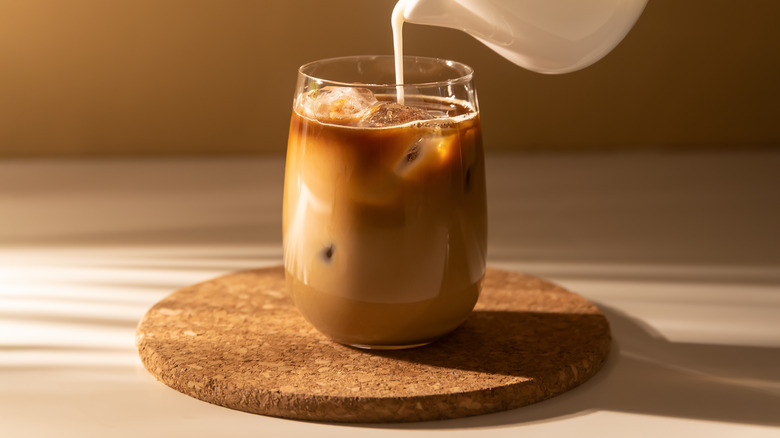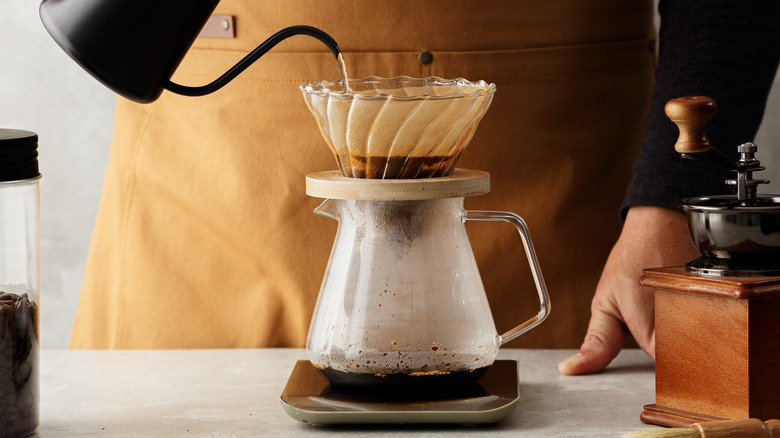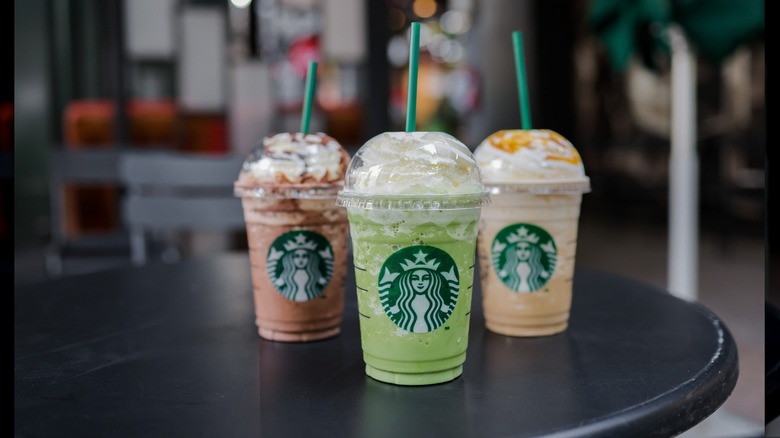The Real Reason Why People Love Iced Coffee Year-Round
Bundled up in thick coats, the winter season in full swing, some brave iced coffee stans will risk it all just for just one sip of their favorite drink. Whether it be a polar vortex or the worst blizzard of the season, nothing seems to deter denizens of iced coffee devotees from imbibing their cold caffeinated prize.
Iced coffee has taken the world by storm throughout many pockets of history, but its popularity seems to be reaching a higher peak than ever. Nowadays, it appears a whole lot of coffee consumers are proudly opting for colder brews over the more traditional hot cup of joe. In an interview with The New York Times, Starbucks founder Howard Schultz recently revealed that cold beverages accounted for 75% of Starbucks beverage sales in their most recent quarter as of this writing. So what is it about an iced coffee that makes it so enticing?
If you want to know the real reason why more and more people love drinking their iced coffee year-round, even in an onslaught of snow, there are a few different factors to consider. Let's start with the chemistry. A lot of iced coffee fans argue that iced brews just taste better than hot. But no matter the temperature, isn't coffee all the same? Actually, not quite.
The science behind your cup of coffee
As one Business Insider article pointed out in 2015, one could argue not all coffee is created equal. Generally, hot coffee is brewed in a matter of minutes. The smell is strong and the taste is normally sour. Now consider iced coffee. Making cold brew means soaking coffee grounds in water and letting it steep for about a day. After the waiting period, you strain the grounds from the liquid, and voila! A cup of cold brew awaits.
As similar as they may sound, the flavors of these two coffees will actually be different. According to Business Insider's science team, the difference lies in the chemistry behind it. The chemical compounds found in coffee, otherwise referred to as solubles, are what give coffee its taste. These special flavors are extracted during the brewing process, during which they oxidize and degrade. Depending on how the coffee is brewed, different oils are brought to the surface. Since solubles dissolve best in hot drinks, hot coffee tends to have a more full-bodied profile than its colder counterpart, as well as the distinct, bitter flavor that a regular cup of joe is famous for.
As Business Insider noted, the oxidation process still happens when you brew your coffee cold, but it happens at a slower rate. The longer process makes for less acidic and more sweet-tasting sips — meaning that in a way, science supports why people might prefer iced drinks to hot. But why are people going so far as to brave the winter chill for it?
The iced coffee craze -- why now?
There are a few different reasons which might account for the current popularity of iced coffee among consumers. In an interview with The New York Times, Starbucks founder Howard Schultz credited the growth to two things: the ability for customers to customize their drink of choice, and how members of Generation Z are purportedly fond of posting photos of these customized beverages on their social media feeds.
Despite Schultz's observations and theories about Gen Z, however, it seems to praise iced coffee online was also a passion of Millennials who came before them, which The Perfect Daily Grind attributed to a mix of "convenience," and, as Schultz hypothesized for the Gen Z said, customizability. And even before that, as GQ noted in a 2019 breakdown of the topic, cold brew was seen as the king (or queen) of beverages for some members of the LGBTQ community, thanks largely to a mix of meme culture and the exchange of those memes in queer online spaces.
So although the love for iced coffee is growing fast — by about 10% annually, according to Mintel – iced coffee's popularity is really not new. So what's going on here? There's a chance it might go back much, much further than the dawn of the Internet age.
Iced coffee's popularity and the world of advertising go hand in hand
According to The Takeout, the real first push for iced coffee goes way back, and it's all thanks to the wide world of advertising. In 1921, a marketing campaign created by the Joint Coffee Trade Publicity Committee of the United States decided to make a push for expanding coffee sales. As The Takeout noted, the only way to do that was to advertise it as a beverage for all seasons, which meant circumventing the issue of how to market a hot drink during the summer seasons. The answer, then, seemed straightforward: Americans already liked iced drinks like tea and soda. So the committee pushed the drink hard, putting pictures of it in papers and magazines, and even distributing their own booklets. It all went up from there.
Indeed, iced coffee's success can largely be attributed to smart marketing. Take Starbucks' attempt to up the beverage's appeal in the U.K. in the 1990s. Per the Wall Street Journal, many people at that time thought promoting the sale of coffee in the British market would ultimately be a lost cause — especially considering how ubiquitous tea was (and largely still is) across the pond. Starbucks leaned into that assumption with an ad campaign featuring a fictional employee named Billy who, per the campaign narrative, was largely ridiculed for "inventing" the Frappuccino — and who was then largely redeemed due to the drink's total success. The marketing push ultimately worked.
Getting caught cold with Dunkin' Donuts
While Starbucks looms large in the world of coffee retailers, it's hardly the only franchise of its kind — and it's also not the only one to contribute to the rise of iced coffee. Take Dunkin' Donuts, for instance. As the New England newspaper The Enterprise reported in 2011, one of Dunkin' Donuts' most successful advertising pushes from that year, titled the "Caught Cold" campaign, centered on a sports tickets giveaway for customers who were — you guessed it — "caught cold" drinking iced coffee in the winter.
Speaking with The Enterprise, Tom Manchester, a marketing expert who oversaw much of the project, explained how it all hinged on novelty as a way to draw people into tasting the drink — and then loving it. "I think just the notion of iced coffee in the wintertime is sort of outside people's normal way of thinking about iced coffee," said Manchester. "I think that people have found that once they try it, they are like, 'Hey, this is great.'"
It seems he was onto something: In a 2012 Dunkin' Donuts survey conducted after the campaign, some 84% of customers admitted they had started drinking more cold coffees in winter. Years later, iced coffee is just about as common as a glass of water — and, despite wind and cold and rain, all the more consumed year-round.




